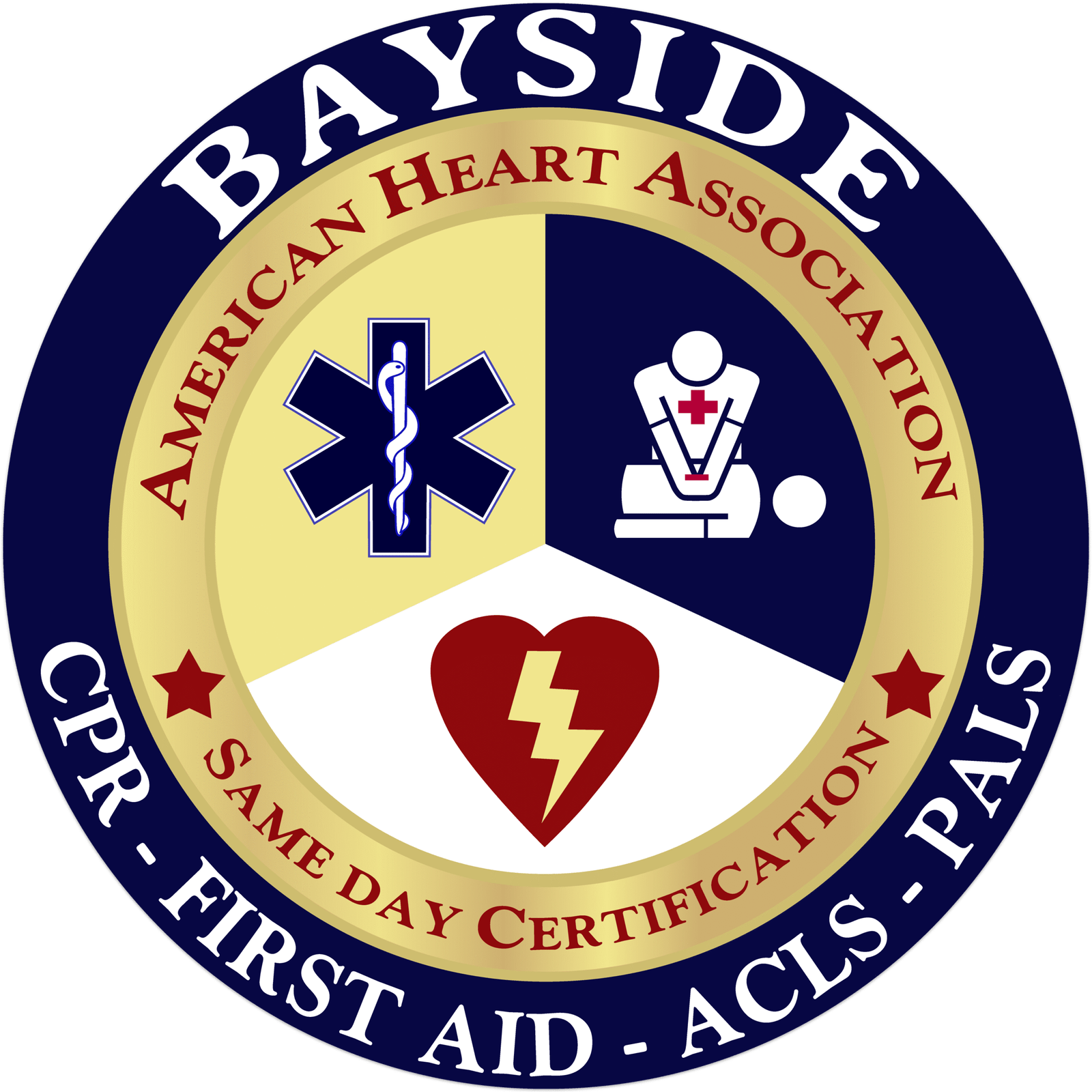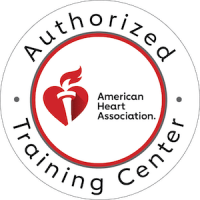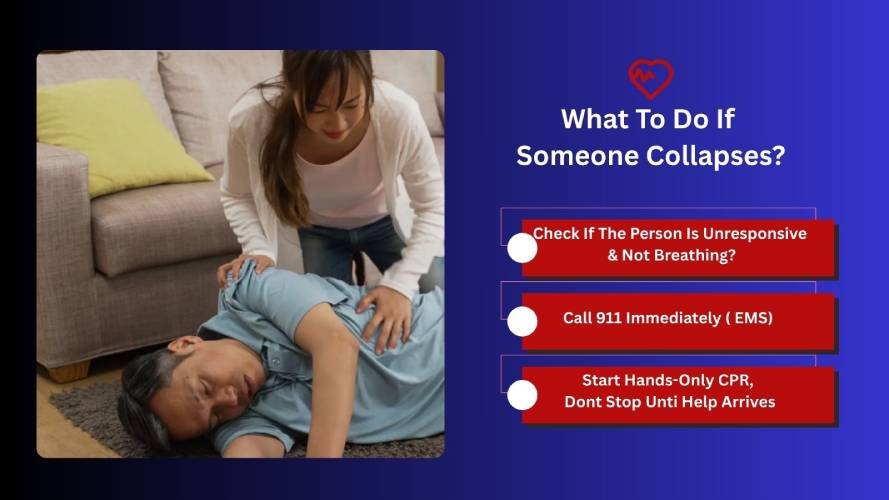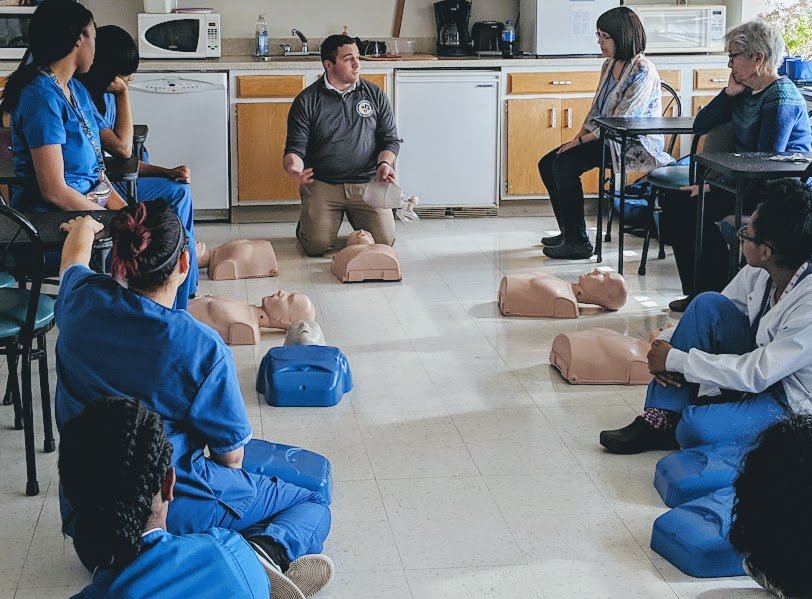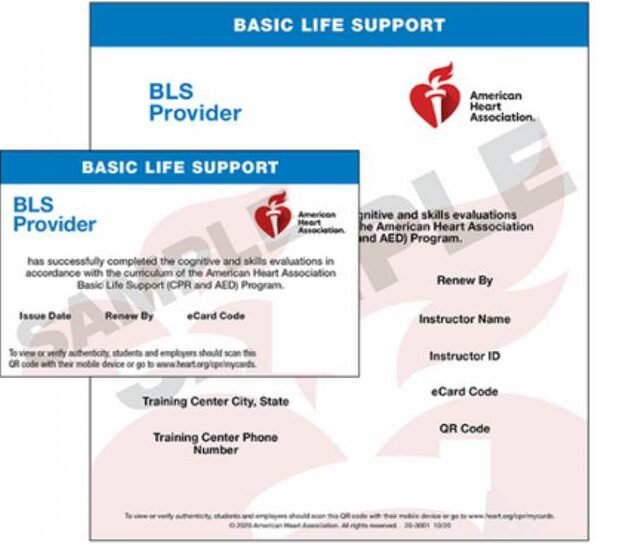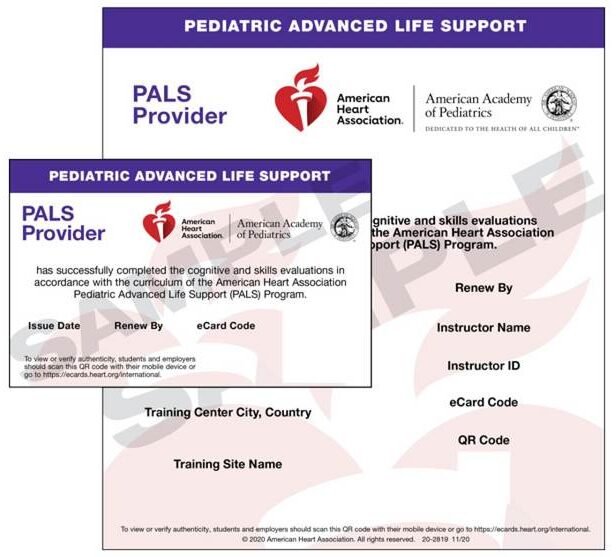It’s a normal day, maybe you’re at work, the gym, or walking down the street, and that’s when suddenly, someone nearby collapses. It’s a terrifying moment and many people freeze in those emergency situations, unsure of what to do. But that’s the biggest mistake you can make, because it’s a matter of life and death.
Remember, the most important thing to do is to always stay calm. Panic won’t help, but your actions do. The next step is to take immediate action to help the person.
This guide will walk you through exactly what to do when someone collapses, even if you haven’t received any formal training. You’ll learn how to perform CPR, how to use an AED (Automated External Defibrillator), and how to recognize the right moment to take action. When you know what to do, you can act with confidence. That’s when you can make a powerful difference, you can save a life.
Understanding Collapse: When Is CPR Needed?
Collapse can mean fainting, seizures, a heart issue, or even a sudden cardiac arrest. Not all collapses are the same, but the most serious kind is when someone suddenly falls, becomes unresponsive, and stops breathing normally. In this case, ready yourself to provide CPR (Cardiopulmonary Resuscitation).
Step-by-Step Emergency CPR
You just need to act with 7- steps immediate CPR when the individual collapses and is unresponsive and not breathing normally or not breathing at all, then you can save a life. In cases of sudden cardiac arrest, quick intervention significantly increases the chance of survival for the person. Here is the step-by-step emergency CPR guide to follow even if you are not trained:
Step 1: Ensure Scene Safety
Before you help someone who has collapsed, take a quick look around. Make sure the area is safe for both you and the person. Look out for things like traffic, live wires, fire, or anything that could hurt you. If the place is dangerous and you can move the person safely, do so.
Step 2: Check for Responsiveness
Approach the person and gently tap them or shout if needed. Check if they give any response, such as movement, eye opening, or verbal reply. If there is no response, the person needs immediate medical assistance.
Step 3: Call Emergency Medical Service (EMS)
If the person is unresponsive, call 911 immediately. If there is someone nearby, ask them to call, and you proceed with the CPR without any delay.
Make sure to state the situation clearly as follows:
- The person has collapsed and is unresponsive.
- The exact location
- Whether the individual is breathing or not
- Request an AED (Automated External Defibrillator) if available.
Step 4: Check for Normal Breathing
Check whether the person is breathing normally, or pulse is present or not. Watch the chest movement and listen for breath sounds. Feel the air from the nose or mouth and check the pulse on the neck using the index and middle finger. Spend no more than 10 seconds here and take action.
What action to take?
- If they have a pulse but aren’t breathing, just give rescue breaths, one breath every 5 to 6 seconds.
- If they are breathing and have a pulse, keep watching them closely and gently put them onto their side until emergency service arrives. This is called the recovery position, and it helps keep their airway clear.
- If the person isn’t breathing and has no pulse, start CPR immediately.
Step 5: Start Chest Compressions
You don’t need to be a medical expert to save a life. If someone isn’t breathing and has no pulse, hands-only CPR can keep their blood flowing until help arrives. Here is how you do it:
Hands-only CPR:
- Place your one hand over the other in the center of the chest (on the lower half of the sternum), interlocking your fingers.
- Keep your arms straight, position your shoulders directly over your hands, and use your body weight to apply force.
- For adults (8 years and above) and children (between 1 year and 8 years), compress the chest at least 2 inches deep and about one-third the depth of the chest for infants (below 1 year).
- Maintain a consistent pace of 100 to 120 compressions per minute, which is about two compressions every second.
- Continue without stopping until medical help arrives or the person starts responding.
If trained, add rescue breaths:
If you are trained for CPR, give 30 compressions followed by two rescue breaths. For this, first tilt their head back and give breaths by pinching the nose and covering the mouth completely if the person is an adult; for children, cover their mouth only and for infants, provide the rescue breaths by covering both the nose and mouth with your mouth.
Step 6: Use an AED if Available
An Automated External Defibrillator (AED) is a portable medical device that analyzes the heart’s rhythm and delivers a shock if necessary. When someone collapses, having an AED nearby can play a big role in saving their life, but only if you know how to use it. Let’s learn how to use it with this easy step-by-step guide:
How to use an AED:
Before you place the AED pads, take off any clothing covering the chest, wipe away sweat or moisture and remove any obstruction to make sure that the pads come in full contact with the chest. Also, do not touch the person while the machine is analyzing or delivering a shock to prevent interference.
AED Pad Placement
For Adults: Place one pad on the upper right side of the chest (just below the collarbone), and the other on the lower left side (below the ribs). Use adult pads as they are bigger and made specifically for adult bodies.
For Children: Use pediatric pads if you have them. Place them the same way as adult pads. Just make sure that if you are using adult pads, they don’t touch each other.
For infants: It is best to use infant pads, but if you don’t have them, you can use pediatric or even adult pads, making sure that they don’t touch each other. Also, lower the AED’s energy setting, as the same amount of shock is harmful for their delicate hearts.
Step 7: Continue with CPR and AED until help arrives
Just be calm and keep following the prompts from the AED if you are using it. You need to alternate between CPR and AED every 2 minutes. Continue like this until the person starts responding or gains consciousness, or emergency medical service arrives.
Doing Something Is Better Than Nothing
Many people hesitate during an emergency because they’re afraid of messing up. They think AEDs are only for medical professionals or that CPR requires certification, but these are all common misconceptions. Just remember the following truths:
- You can’t make it worse, as the person is already in cardiac arrest.
- Hands-only CPR is simple and safe for anyone to try.
- Act quickly, and you double or triple their chance of survival.
We spend most of our time in the workplace, don’t we? According to a report from the U.S. OSHA, about 10,000 cardiac arrests occur at work every year. When defibrillation is applied immediately, the survival rate is around 60%. But if we wait for EMS to arrive, it drops drastically to just 5–6%. So, in case any of your colleagues collapses and you’re the one nearby, don’t hesitate. Don’t rethink. Act. Start CPR, grab the AED, follow prompts, and continue until medical help arrives.
Final Thoughts: Immediate Action is a Life Saver
Cardiac arrest can happen anywhere, anytime, and to anyone. By following the above mentioned simple step-by-step emergency guide, you can save someone’s life. Even if you’re not certified or trained, your actions matter.
In a life-threatening situation, waiting for help without doing anything can reduce survival chances. Whether you make an immediate 911 call, perform hands-only CPR, or use an AED, your quick action could save a life, so don’t hesitate to act. Here at Bayside CPR, we prepare you for any emergency by offering a range of emergency healthcare courses. Enroll in our CPR and AED training course at your convenience.
